Letters from Lodi
An insightful and objective look at viticulture and winemaking from the Lodi
Appellation and the growers and vintners behind these crafts. Told from the
perspective of multi-award winning wine journalist, Randy Caparoso.
The historic relationship between Lodi's Zinfandel and unforgotten Tokay
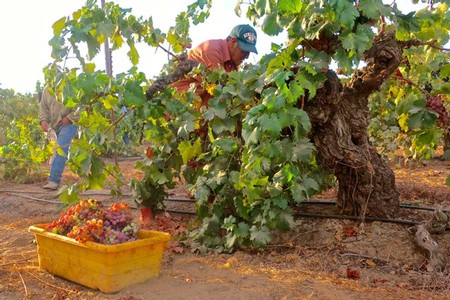
Harvesting of 130-year-old Tokay vines in Jessie's Grove estate
When I first moved to Lodi, just before the 2010 harvest, one of the conversations that taught me most about the region was with longtime grower Jonathan Wetmore, who owns the Lodi based vineyard management company called Round Valley Ranches. Round Valley Ranches farms over 2,000 acres of wine grapes for both large wineries (such as E. & J. Gallo) as well as some of the region’s most celebrated specialty estates, such as Acquiesce Winery, Oak Farm Vineyards, and Jessie’s Grove.
“There have been a lot changes since when I first started in the industry,” said Wetmore. “In the seventies, harvest never started until after Labor Day, and only because that was when Gallo opened its doors to receive grapes. There was no Cabernet Sauvignon, Merlot, or Sauvignon blanc to deliver – those varieties weren’t yet planted in Lodi at the time. It was primarily Zinfandel for wine production, but the most widely planted grape of all was the big, seeded table grape called Tokay, also known as Flame Tokay. In fact, from late 1800s up until that time, Tokay was the premier grape in Lodi.”
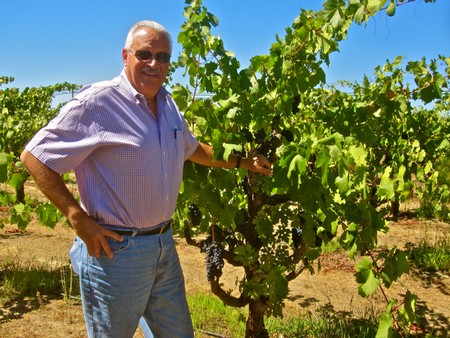
Round Valley Ranches' Jonathan Wetmore with vertically head trained Zinfandel
Wetmore also recalled many of the traditions still followed by the industry forty years ago. “We never picked Zinfandel until the 20th of September,” said Wetmore, “and a lot of it had to be done by at least a week before Columbus Day in October because Columbus Day was when the Italians on the East Coast traditionally made their wine, and we’d need at least a week to get the grapes over to them by rail.
“Because most of the Zinfandel in Lodi was on head trained vines, everything was picked one lug box at a time, which was time consuming. So we’d start the zin harvest in September, when the grapes were around 22° or 23° Brix (i.e. sugar reading), or 24° at the most, although it could get much higher by the end of October if that’s how long it took to get done. What didn’t get shipped back East was sent to the big co-op wineries that dominated in the Lodi region up until the seventies. These grapes went into generic reds like Burgundy and Chianti, or into Ports – not very good wines, though even then we knew the grapes were a lot better than what they were made into. This is what gave Lodi a bad rap, which took us a long time to overcome.”
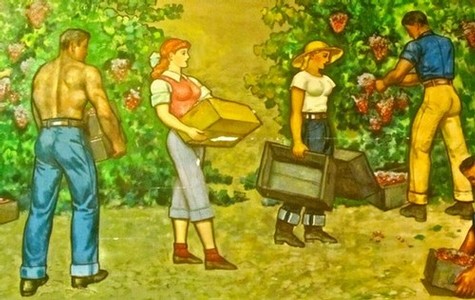
From a 1960 mural by John Garth depicting the Lodi Tokay harvest, in Ole Mettler Pavilion (Lodi Grape Festival)
Driving eastwards over the Mokelumne River along Peltier Rd. – skirting the north side of the little towns of Woodbridge and Acampo, and the City of Lodi – Wetmore talked about the historic, almost symbiotic relationship that existed between Zinfandel and Tokay, ever since both grapes were introduced to the region some time during the 1860s: “The interesting thing about Zinfandel and Tokay, which grew side by side in the old part of Lodi – in what is now known as the Mokelumne River AVA – is that both grapes absolutely thrived in the region’s deep, rich, fine sandy loams (officially classified as Tokay sandy loam).
“The old timers always knew that wherever you could get the Tokay to turn its bright pink color, you could also grow the highest quality Zinfandel. Lodi was the king of Tokay because you couldn’t successfully grow it anywhere else in California. You needed the moderating, cooling breezes from off the Delta, and even then not in every part of Lodi because you also need that fine sandy loam for those vines to get their wild root systems deep enough to get established.
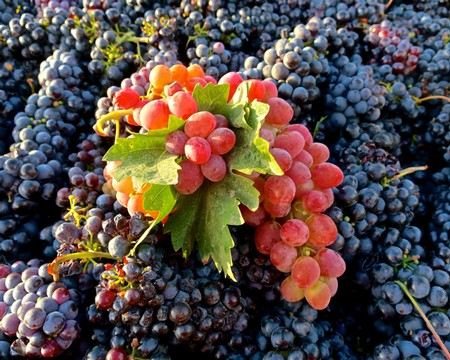
Tokay harvested with Zinfandel grapes in Jessie's Grove's Royal Tee Vineyard (planted in 1889)
“Here along Peltier Rd., for instance, on the south side of the road both Tokay and Zinfandel could ripen beautifully. But on the north side of Peltier Rd. (in the sub-appellation now recognized as the Jahant AVA), we couldn’t quite get the Tokay to turn color and ripen as nice, big clusters. It is possible to grow good Zinfandel in Jahant, or in hillier areas like Clements Hills AVA on the east of town, but only where the clay soils are mixed with enough sand – primarily in small pockets closer to the Mokelumne River, where sandy soils are deep enough."
If anything (calling all wine geeks!), Wetmore’s story of Zinfandel and Tokay’s century-long relationship serves as a graphic demonstration of what the French call terroir – or "sense of place." Soil and other topographical factors definitely impact grape cluster quality and morphology, which directly impact qualities and characteristics of resulting wines. What won’t matter is growing grape varieties in the wrong places, where they can’t naturally ripen to optimum levels. Hence, the historic reason why there has always been three or four times more Zinfandel grown in Lodi than, say, a Sonoma County, Napa Valley or Livermore Valley.
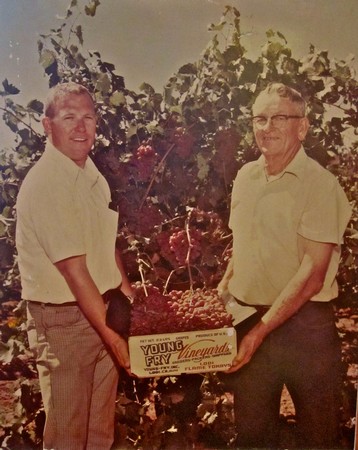
A younger Jerry Fry (left) with a circa-1960s Tokay harvest
“In a lot of ways, growing Tokay for the table grape market also taught us how to grow wine grapes like Zinfandel,” said Wetmore – an observation echoed by Mohr-Fry Ranches’ Jerry Fry, who fully acknowledges that practices like shoot thinning and leaf pulling to achieve a dappled sunlight in order to fully ripen Tokay was also what taught them to grow top quality Zinfandel – decades before the canopy management concepts advanced by modern day viticultural gurus such as Dr. Richard Smart (re Smart’s landmark 1991 book, Sunlight into Wine). Says Fry, “We pulled leaves to knock out leaf hoppers and concentrate the color and flavor of our Tokay, and so it only made sense to take care of our Zinfandel the same way.”
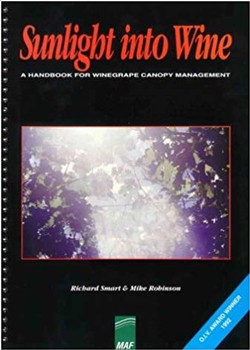
As it were, demand for Lodi’s venerable Tokay grapes vanished fairly quickly during the mid-1980s after the widespread introduction of seedless grapes such as the hybridized Flame Seedless, which is better suited for warmer districts further south in California's Central Valley. Lodi's thousands of acres of Tokay were unceremoniously pulled out in favor of wine grapes such as Cabernet Sauvignon and Chardonnay, suddenly in great demand by the rapidly growing wine production industry. Today, precious few plantings of old fashioned Tokay plants exist – mostly as front-yard heirlooms or ornamentals, if not left to grow wild and unkempt among patches of weeds.
Lodi’s thousands of acres of old vine, wild rooted Zinfandel might have suffered the same fate by the end of the eighties if not for the sudden popularity of White Zinfandel. Of course, even 50-plus-year old vines cropped at 8 or 10 tons per acre and picked at 19° or 20° Brix for White Zinfandel produced basically “flavorless grapes,” in Wetmore’s words, but for light, fruity, inexpensive pink wines this was just fine.
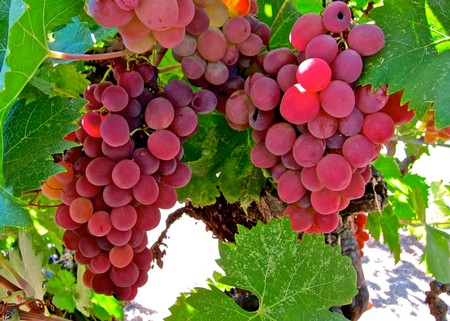
Stunning Tokay clusters, still growing in front yards on east side of Lodi
For more premium quality red wine production, winemakers prefer Zinfandel to be picked at higher sugars – at least 24° Brix, or as high as 28° (which can easily be “adjusted” in the winery to lower alcohol, with judicious doses of added acidity) – when the grapes have attained richer, riper flavors. But to produce that kind of red wine, growers and vintners usually have to work together to crop their vines closer to 3 or 4 tons per acre.
Tokay may be a symbol of the past; but thanks to the wiles and resilience of industry leading growers like Wetmore, or the Frys of Mohr-Fry Ranches, Lodi's meticulously grown old vine Zinfandels grown for the premium quality market ($18 and up in the retail) have continued to grow over the past ten years, even while the market for White Zinfandel and value priced red Zinfandel ($10 or under) have steadily waned.
Still, one thing that should never be forgotten: Without Tokay, Lodi Zinfandel may not have been what it is today!
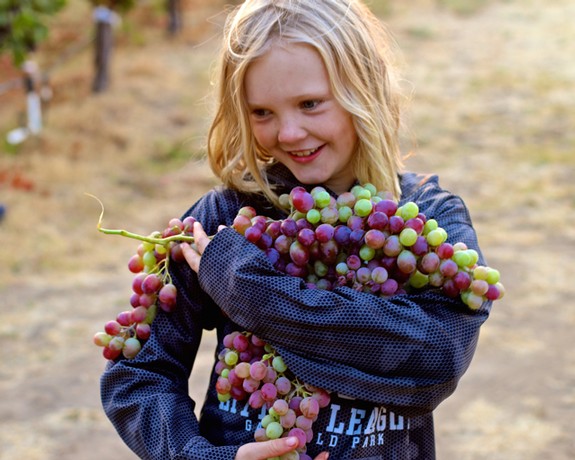
Ancient vine Tokay cluster